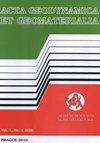Liquefaction potential along with pore water pressure generation of coastal sand of Digha in West Bengal, India
IF 0.8
4区 地球科学
Q4 GEOCHEMISTRY & GEOPHYSICS
引用次数: 0
Abstract
Stress controlled cyclic triaxial tests have been done on coastal sand of Digha, West Bengal, India, at different frequencies, confining pressures, and relative densities and cyclic stress ratios. Number of cycles for initial liquefaction (NL) has been determined for that number of cycle when excess pore pressure ratio has become equal to 1. Significant influences of density of sand, confining pressure and number of cycles for initial liquefaction on coastal Digha sand have been found. The test results have shown that increasing density of sand increases liquefaction potential, whereas cyclic strength of sand decreases with increase of confining pressure. An empirical correlation has been developed on cyclic strength of sand based on these parameters and this correlation fits quite well with the observed experimental results. Bender Element tests have been performed to determine maximum shear modulus (Gmax) of Digha sand at different densities and confining pressures. A high correlation coefficient between cyclic strength and Gmax of Digha sand at any NL has been found. A new pore water pressure generation model has been introduced for this sand along with upper bound and lower bound curves to predict excess pore water pressure build up due to seismic loads. ARTICLE INFO印度西孟加拉邦迪加海岸沙的液化潜力和孔隙水压力的产生
在印度西孟加拉邦迪加的海岸沙上进行了应力控制循环三轴试验,试验频率、围压、相对密度和循环应力比不同。当过孔隙压力比等于1时,已经确定了初始液化的循环次数(NL)。研究发现,砂土密度、围压和初始液化循环次数对迪加海岸砂土有显著影响。试验结果表明,随着围压的增加,砂土密度的增大,砂土的液化潜力增大,而砂土的循环强度减小。基于这些参数,建立了砂土循环强度的经验关系式,该关系式与实测结果非常吻合。Bender单元试验用于确定不同密度和围压下Digha砂的最大剪切模量(Gmax)。在任何NL下,Digha砂的循环强度与Gmax之间都存在很高的相关系数。针对这种砂,引入了一种新的孔隙水压力生成模型,以及上限和下限曲线,以预测地震荷载引起的过量孔隙水压力。文章信息
本文章由计算机程序翻译,如有差异,请以英文原文为准。
求助全文
约1分钟内获得全文
求助全文
来源期刊

Acta Geodynamica et Geomaterialia
地学-地球化学与地球物理
CiteScore
2.30
自引率
0.00%
发文量
12
期刊介绍:
Acta geodynamica et geomaterialia (AGG) has been published by the Institute of Rock Structures and Mechanics, Czech Academy of Sciences since 2004, formerly known as Acta Montana published from the beginning of sixties till 2003. Approximately 40 articles per year in four issues are published, covering observations related to central Europe and new theoretical developments and interpretations in these disciplines. It is possible to publish occasionally research articles from other regions of the world, only if they present substantial advance in methodological or theoretical development with worldwide impact. The Board of Editors is international in representation.
 求助内容:
求助内容: 应助结果提醒方式:
应助结果提醒方式:


